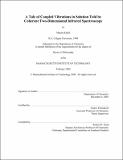| dc.contributor.advisor | Andrei Tokmakoff. | en_US |
| dc.contributor.author | Khalil, Munira, 1975- | en_US |
| dc.contributor.other | Massachusetts Institute of Technology. Dept. of Chemistry. | en_US |
| dc.date.accessioned | 2005-05-17T14:39:07Z | |
| dc.date.available | 2005-05-17T14:39:07Z | |
| dc.date.copyright | 2004 | en_US |
| dc.date.issued | 2004 | en_US |
| dc.identifier.uri | http://hdl.handle.net/1721.1/16607 | |
| dc.description | Thesis (Ph. D.)--Massachusetts Institute of Technology, Dept. of Chemistry, 2004. | en_US |
| dc.description | Vita. | en_US |
| dc.description | Includes bibliographical references. | en_US |
| dc.description | This electronic version was submitted by the student author. The certified thesis is available in the Institute Archives and Special Collections. | en_US |
| dc.description.abstract | Coherent two-dimensional infrared (2D IR) spectroscopy is used as a tool for investigating the molecular structure and dynamics of coupled vibrations in solution on a picosecond timescale. The strongly coupled asymmetric and symmetric carbonyl stretches of Rh(CO)₂C₅H₇0₂ (RDC) dissolved in hexane serve as a convenient model system. Fourier transform 2D IR spectra are obtained from heterodyne-detected third-order nonlinear signals using a sequence of broad bandwidth femtosecond IR pulses. A 2D IR correlation spectrum with absorptive lineshapes results from the addition of 2D rephasing and non-rephasing spectra, which sample conjugate frequencies in the evolution time period. The 2D IR correlation spectrum contains peaks with different positions, signs, amplitudes and lineshapes. The positions of the peaks map the transition frequencies between the ground, singly, and doubly excited states of the system, and thus describe the anharmonic vibrational potential. Peak amplitudes reflect the relative magnitudes and orientations of the transition dipole moments in the molecular frame, the electrical anharmonicity of the system, and the vibrational relaxation dynamics. The 2D line shapes are sensitive to the complicated system-bath interactions in solution. 2D IR spectra taken with varying polarization conditions and as a function of a variable waiting time can be used to isolate and quantify these spectroscopic observables. The polarization-selective 2D IR spectra of RDC in hexane are analyzed in terms of two coupled local coordinates to obtain their mutual orientation and the magnitude of the coupling between them. Evidence of vibrational coherence transfer between close-lying transition frequencies is indicated by the presence of extra induced peaks in 2D IR | en_US |
| dc.description.abstract | (cont.) rephasing spectra. The data is modeled by using Redfield theory to account for coherence transfer, vibrational dephasing and population relaxation in a multilevel vibrational system. Building on the studies of the RDC model system, 2D IR spectroscopy is used to study the thermal denaturation of RNase A by characterizing the temperature-dependent Amide I band. A nonlinear IR probe is used to study the early events in the laser temperature-jump initiated denaturation of RNase A. | en_US |
| dc.description.statementofresponsibility | by Munira Khalil. | en_US |
| dc.format.extent | 173 leaves | en_US |
| dc.format.extent | 4257666 bytes | |
| dc.format.extent | 45540326 bytes | |
| dc.format.mimetype | application/pdf | |
| dc.format.mimetype | application/pdf | |
| dc.language.iso | eng | en_US |
| dc.publisher | Massachusetts Institute of Technology | en_US |
| dc.rights | M.I.T. theses are protected by copyright. They may be viewed from this source for any purpose, but reproduction or distribution in any format is prohibited without written permission. See provided URL for inquiries about permission. | en_US |
| dc.rights.uri | http://dspace.mit.edu/handle/1721.1/7582 | |
| dc.subject | Chemistry. | en_US |
| dc.title | A tale of coupled vibrations in solution told by coherent two-dimensional infrared spectroscopy | en_US |
| dc.type | Thesis | en_US |
| dc.description.degree | Ph.D. | en_US |
| dc.contributor.department | Massachusetts Institute of Technology. Department of Chemistry | |
| dc.identifier.oclc | 55628938 | en_US |

